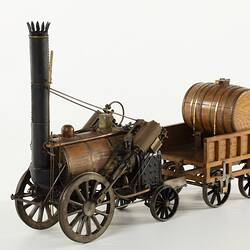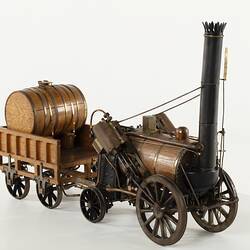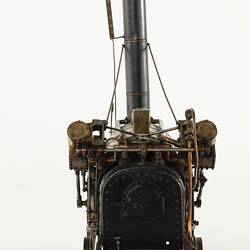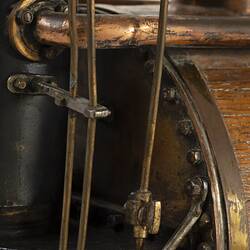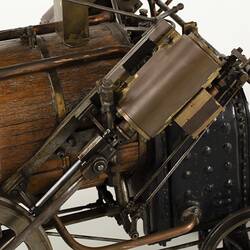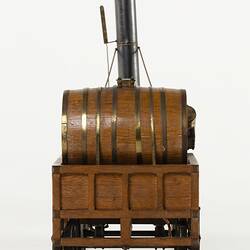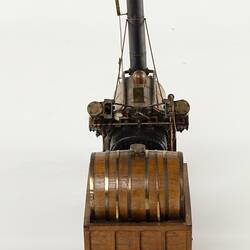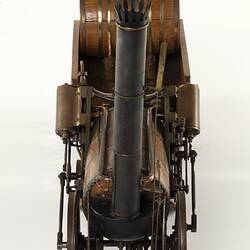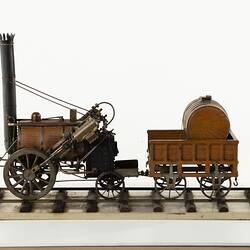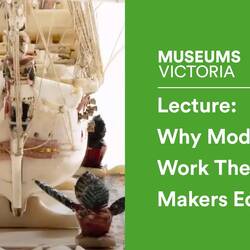Summary
Model depicting the "Rocket", a steam locomotive built by Robert Stephenson & Co., Newcastle upon Tyne, which won the Rainhill locomotive trials conducted by the Liverpool & Manchester Railway Company in October 1829. The "Rocket" was designed by Robert Stephenson, with contributions from his father George Stephenson, chief engineer of the Liverpool & Manchester Railway and Henry Booth, secretary of the Railway Company. The model was built by students of the Brunswick Technical School in 1952-4. Scale 1:8. The "Rocket" set the precedent for all subsequent steam locomotives, incorporating significant innovations such as the multi-tubular boiler and exhaust steam blast pipe, which greatly improved boiler efficiency.
Constructed as a project in the Engineering Faculty, Brunswick Technical School 1952-1954. The donor, Mr John H.White, was chief engineering instructor at the school.
Physical Description
Metal and wood model of a steam locomotive and tender. The locomotive has a tall chimney and piston driven wheels. The tender resembles an open cart and has a barrel inside.
Significance
Statement of Significance:
The "Rocket" designed by George & Robert Stephenson and Henry Booth, and built by Robert Stephenson & Co., of Newcastle-upon-Tyne, was the clear winner of the Rainhill Trials held by the Liverpool and Manchester Railway in October 1829, which established the steam locomotive as a practical means of locomotion for public railways carrying both goods and passenger traffic. During the trials over a one and a half mile stretch of track, the 'Rocket' covered 35 miles in 3 hours 12 minutes, hauling 13 loaded wagons (three times its own weight) at 12.5 miles per hour (20 km/hr) and a single carriage with passengers at 24 miles per hour (39 km/hr). The locomotive on its own achieved a maximum speed of 29 miles per hour (46 km/hr), setting a new world record for railway speed. The "Rocket" weighed 4.25 tons.
The "Rocket" represented a substantial technical advance on previous steam locomotive designs, bringing together in one machine such important developments as the multitubular boiler and blast pipe which directed exhaust steam up the chimney increasing the draught through the firebox. It also, however, had a number of short comings such as the leading single-axle driving wheels, creating problems with lack of adhesion and traction, and cylinders inclined at 35 degrees to horizontal, which while a distinctive feature of the engine, created serious out of balance forces causing the locomotive to sway from side to side at speed.
In 1830, the "Rocket" was rebuilt and was then employed on the Liverpool & Manchester Railway, gaining further notoriety for an accident in which it knocked down and killed a British member of parliament during the railway's opening celebrations on 13 September 1830. The "Rocket" was retired from service during the late 1830s, by which time its design was well and truly superseded. Its incomplete remains were subsequently given to the London Science Museum.
More Information
-
Collecting Areas
-
Acquisition Information
Donation from Mr John White, 12 Nov 1962
-
Modelmaker
Engineering Faculty, Brunswick Technical School, Dawson Street, Brunswick, Greater Melbourne, Victoria, Australia, circa 1952
Model made by students. -
Modelmaker
Mr John H. White, Melbourne, Greater Melbourne, Victoria, Australia, circa 1952
Teacher co-ordinating project. -
Manufacturer of Item Modelled
Robert Stephenson & Sons, Newcastle upon Tyne, Northumberland, England, Great Britain, circa 1829
-
Classification
Rail transport, Railways - steam power, Model steam locomotives
-
Category
-
Discipline
-
Type of item
-
Overall Dimensions
1000 mm (Length), 300 mm (Width), 580 mm (Height)
Approximate overall dimensions for locomotive engine and tender.
-
Part Dimensions
510 mm (Length), 270 mm (Width), 560 mm (Height)
Dimensions for locomotive engine only.
-
Part Dimensions
460 mm (Length), 270 mm (Width), 300 mm (Height)
Approximate dimensions for tender only.
-
Keywords
Liverpool & Manchester Railway, Rainhill Locomotive Trials, Liverpool & Manchester Railway, 1829, Steam Railway Locomotives, Model Steam Railway Locomotives

